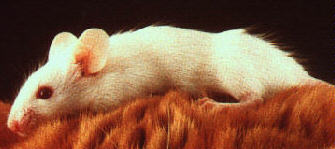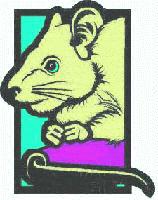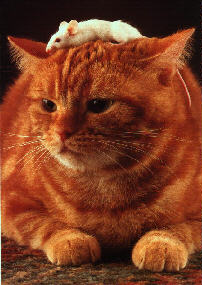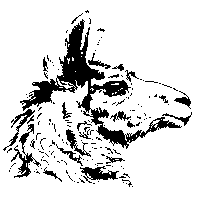 Mouse
Mouse

The mouse, Mus musculus, is a rodent who originated in temperate Asia. The domestication and breeding of domestic mice has led to a great variety of colors and types. There are many wild cousins, the domestic mouse is not the same as the field mouse.
Mice as Pets
Mice, if handled gently, can make good, small pets. They are timid, social, omnivores, territorial and easily escape their cages. They only weigh 1-2 ounces. They do not tend to bite, but some types are more aggressive than others. Wild mice are nocturnal, but domestic mice can have periods of activity both day and night. They are secretive, love to burrow, and build nests. Humans can develop allergies to the dander, urine or hair of mice. Male mice may have an offensive odor to their urine.
[ Menu ]
Housing
Mice can be housed in wire or plastic cages but care must be taken to prevent escape or fractured limbs in wire. Cages should be spacious and at least 5-6 inches high. Bedding can be sawdust, paper, shavings and should be dust-free and inedible Avoid pine or cedar shaving as these may affect the mouse’s liver. Temperatures of the room should be between 65°F and 80°F.
Mice tend to drink lots of water and, therefore, urinate a lot. Cages need to be changed as often as necessary, but at least twice a week. The mice are very sensitive to the build up of ammonia from the urine.
Mice are social animals and do much better in groups of 2-6 animals. Mice living alone tend to be more aggressive. However, two male mice living together tend to fight and may continue to do so even after living together for quite a while. Introduction into male only groups at weaning may be acceptable if the cage is large and there are lots of escape places for hiding. Neutering will help this situation, but the easiest solution is to keep female mice only.
[ Menu ]
Food and Water
Food should be as fresh as possible and bought in small amount (or stored frozen) to insure freshness. Feeding can be free choice and water should always be available. The diet should have approximately 14% protein and 4-5% fat.
[ Menu ]
Life Span
Mice can live for 2-3 years depending on the strain of mice, however, the typical domestic mouse lives 1-1 1/2 years.
[ Menu ]

Handling and Medical Care
Do not pick a mouse up by the tip of its tail or you may pull the skin off. You can, however, briefly pick the mouse up by its tail near the base of the tail. The scruff of the neck can also be used, but only use these if the mouse cannot be handled in a more gentle manner.
In group situations, mice may groom each other to the point of baldness. Usually only one mouse is performing this activity, so the culprit will have all of its own hair but everyone else will have some missing.
[ Menu ]
Web Sites
Enjoy!
 Mouse
Mouse
 Mouse
Mouse

 ||
||  ||
|| 